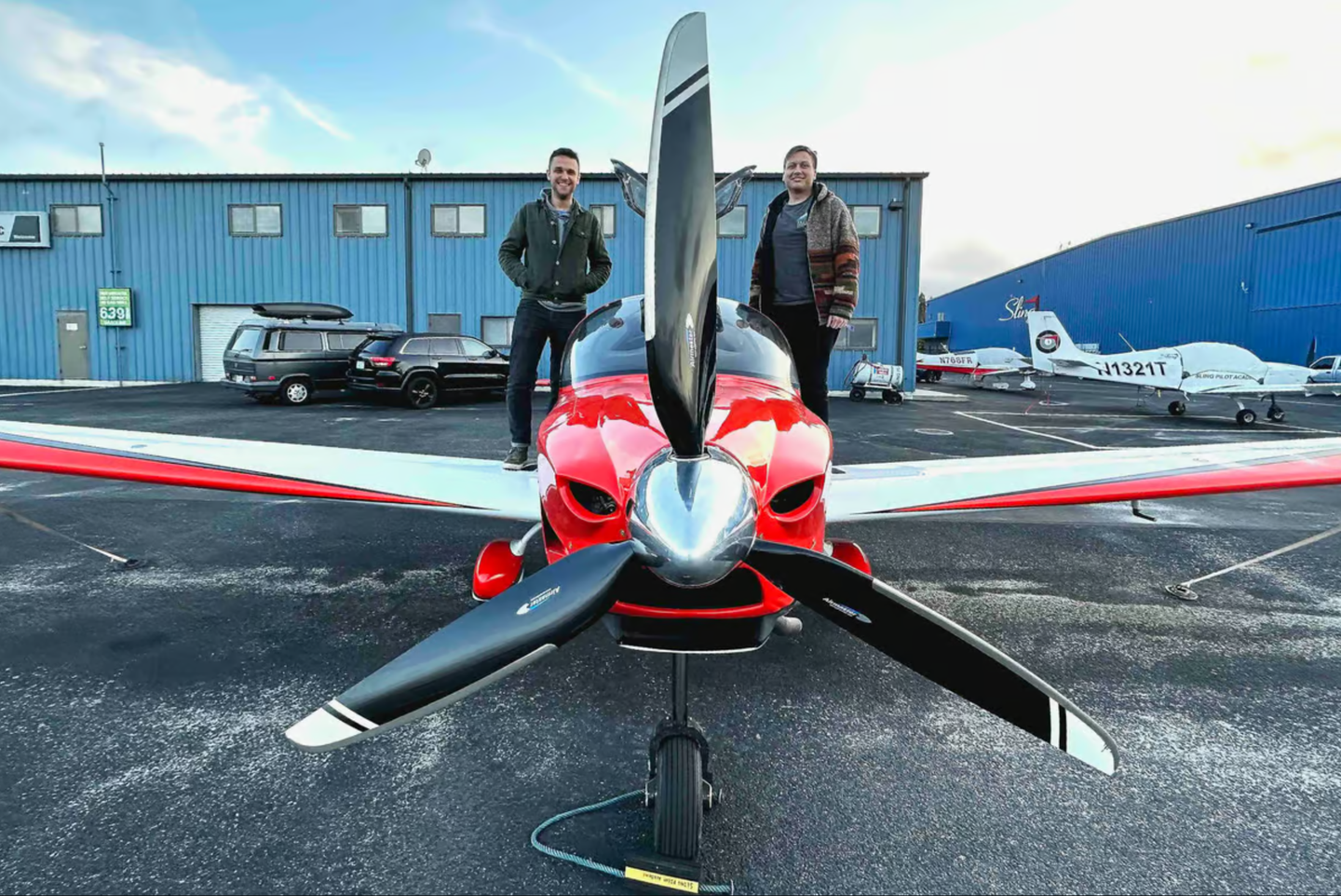Former SpaceX engineer plans to turn small planes into the next family car
Airhart aims to simplify personal aviation with intuitive flight controls and accessible small aircraft requiring only 1 hour of training.

Nikita Ermoshkin (left) and his co-founder, Soren Rademacher. (CREDIT: Airhart Aeronautics)
In 2020, an engineer named Nikita Ermoshkin began training for a private pilot license. His plan was simple: fly between Los Angeles and San Francisco to visit friends and grab a burrito at his favorite spot. What started as a personal hobby soon turned into something more ambitious—a mission to simplify flying for everyone.
While learning to fly, Ermoshkin was surprised by how complicated small aircraft still were. Despite all the technology packed into modern cars, flying still felt like wrestling with outdated controls. “It’s kind of like driving a manual car with two steering wheels,” he said. That realization launched him on a new path.
After three years at SpaceX, where he worked on the Falcon 9 rocket's fairing recovery program, Ermoshkin made a bold move. He left the company and teamed up with two other engineers to launch a startup called Airhart Aeronautics. Their goal was to build an aircraft so simple that almost anyone could fly it—with as little as an hour of training.
Turning Complex Systems Into Simpler Ones
Ermoshkin and his co-founders didn’t set out to create a flying car or an electric jet. Instead, they focused on making flying easier through smarter controls and better design. Just like automatic transmission changed how people drive, Airhart aims to change how people fly.
Their first prototype, known as the Airhart Sling, is a four-seat airplane developed in partnership with Sling Aircraft. The design uses a fixed-wing model that’s been around for over a century. The innovation lies in the interface: a flight control system that reacts intuitively. You push the stick left or right to turn, forward or back to climb or descend. No complex gauges or multi-step procedures. “It’s more like using an iPad than flying a traditional airplane,” said Ermoshkin.
Unlike most aviation startups chasing battery breakthroughs or futuristic propulsion, Airhart sticks with proven mechanics. The real change is in the user experience. That’s what Ermoshkin believes will unlock a new kind of aviation.
Related Stories
Built on Existing Infrastructure
To test whether their idea could work at scale, the Airhart team studied America’s airfields. They found that of the country’s roughly 19,000 airports, fewer than 100 serve commercial flights. The rest—small general aviation airports—are scattered across the map, often just minutes from suburban neighborhoods. Most are barely used.
That underused infrastructure represents a big opportunity. Ermoshkin believes small, affordable planes could fill the gap, allowing families or individuals to travel faster than ever. He points to common road trips, like driving from Los Angeles to Mammoth Lakes. That journey takes seven hours without traffic. In an Airhart Sling, the flight would last under two hours.
This is part of the broader goal: turning regional flying into something as normal as driving across town. “Fundamentally, we are creating a new market here,” Ermoshkin said.
A New Kind of Pilot
Flying a plane still comes with regulatory and licensing challenges. Today, anyone flying the Airhart Sling needs a traditional private pilot license. The aircraft also falls into the FAA’s experimental/amateur-build category, which limits commercial use. But Ermoshkin is already looking ahead.
One key pathway is through MOSAIC, a future certification rule that could make it easier to approve light aircraft for broader use. While regulatory approval takes time, Airhart is already preparing by proving their system’s simplicity through testing.
In their simulator trials, people with no flying experience were able to take off, fly, and land in less than 10 minutes. The controls were that intuitive. “When our simulator system is turned on, they could fly, take off, and land in like 10 minutes,” Ermoshkin said. That’s a sharp contrast to the traditional process, which took him 80 hours to earn a private license and 50 more for an instrument rating.
Still, the company remains grounded in safety and realism. They’re not claiming you can skip training altogether. But their aim is to reduce it enough that flying no longer feels like a career choice—it becomes just another mode of travel.
SpaceX Roots, Down-to-Earth Vision
Much of Airhart’s core team came from the aerospace world. Ermoshkin himself spent years helping recover rocket parts that returned from orbit. But while rockets were thrilling, the work felt distant from daily life. His passion for flying pushed him toward something more personal—and more practical.
“What motivated me was that I had just learned how to fly a year earlier, and I really loved it,” he said. “But I also noticed how complex and difficult it is… we have this better way to travel, but why is nobody doing it?”
Flying is often seen as a niche hobby or luxury for the rich. But Ermoshkin sees wider potential. In his experience, many people in aerospace are drawn to flying small planes. He just wants to make it easy enough that more people outside that world can try it too.
Even his own motivation was humble: “The true reason I wanted to get a pilot license was so I could fly to San Francisco to get burritos,” he laughed.
The Road Ahead
There are still hurdles to clear. Certification, mass production, and public perception all pose challenges. But Ermoshkin is optimistic. “Like any aerospace company, regulation and certification is always a big question mark,” he said. “It’s just a matter of working through the certification plan with regulators.”
For now, Airhart is focused on what it can control: making flying feel less like engineering and more like driving. With thousands of underused airfields and a team dedicated to changing the experience—not the engine—the company hopes to turn the dream of personal aviation into an everyday choice.
After all, the pieces are already in place. As Ermoshkin put it, “We have all this technology available and all of this infrastructure available to us to get around faster and more efficiently, and we just don’t currently utilize it.”
Note: Materials provided above by The Brighter Side of News. Content may be edited for style and length.
Like these kind of feel good stories? Get The Brighter Side of News' newsletter.



